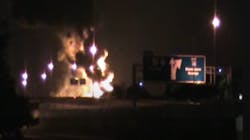FF on 2010 NC Tank Fire: 'It was an Impressive Operation'
GREENSBORO, NC—Assistant Chief Pat Henley recalls being "overwhelmed" when he first pulled up to the massive fire at Colonial Pipeline 10 years ago today.
Henley scrambled to get personnel, foam, hose and pumps to the 52,000-barrel gasoline tank off Interstate 40 and Gallimore Dairy Road.
- RELATED: Blaze Hits NC Gas Tank Farm
A battalion chief at Station 40 on the other side of the city, Henley didn't have much training in how to fight a tank fire.
“I was overwhelmed," Henley recalled. “I just didn’t have a lot of knowledge on the tank operations.”
Nonetheless, what could have been a disaster — there were 72 gasoline tanks on the 268-acre site — was averted.
Henley attributes that to the tremendous teamwork among the 150 emergency workers who ultimately responded.
While he didn’t have expertise in combating these types of blazes, firefighters from the city’s western edge — where the tank farm and Piedmont Triad International Airport are located — did. Just a few weeks prior, they had conducted a joint training exercise with Colonial personnel at the tank farm.
And Colonial employees were on the scene quickly, one of whom Henley said was especially helpful with advice and reassurances that the firefighting effort was on the right track.
“That was the biggest help to me, that we were starting in the right process because, honestly, I didn’t know if we were or not,” he said.
Firefighters responded that Sunday just before 1 a.m. after Colonial employees and motorists along Interstate 40 called 911.
A massive bolt of lightning had struck the tank, overwhelming the container’s electrical-grounding system and igniting the fire, said Jim Robinson, who is currently a deputy chief of emergency services for the city.
“It lights up the entire night sky,” said Robinson, adding that the grounding system on the tank was four times what was required at the time. “I don’t know if eight times the required grounding would have helped in this situation.”
Initially, the fire only burned around the rim of the tank's geodesic dome, which is about 120 feet in diameter.
“About a minute before I got there, they said that the roof had fallen in, and they had a fully-involved tank,” Henley said.
The tank contained almost a million gallons of gasoline at the time, Robinson said. And two other tanks were only 50 feet away.
Henley worked to get everything into place so the attack on the blaze could begin.
“The principal behind any tank fire ... is you never start trying to put it out until you know you have enough foam on-scene,” he said. Otherwise, the foam runs out and the fire just keeps burning."
But it took several hours to get enough foam.
Henley requested the closure of Interstate 40 and enlisted help from departments in Raleigh and Charlotte, which could bring additional foam and help monitor air quality in the area.
It was the first and only "all-call" fire in Henley's 32-year career.
"We had chiefs coming in. We had captains coming in. They were reporting to their station, picking up their gear and coming to Station 20, which is close to the airport."
At one point, Henley said, he was a bit dazed by the scene unfolding before him as the massive fire continued to burn.
“Chief (Bobby) Nugent, our current fire chief, he came up and he knocked on my window of the car,” Henley recalled. “He said, ‘How are you doing?’ I said, ‘I think I’m a bit overwhelmed, chief.’"
"We need to get water on those tanks," Nugent responded.
It was the nudge Henley said he needed.
“He kind of refocused me,” he said. "I needed to get water on the surrounding tanks to keep them cool because we weren’t going to do anything with the tank that was burning for a while. It took 10 or 12 companies to get the hose down there. They had to cut through fences. They were in some pretty bad situations down close to the dikes where the tank would’ve fell."
Robinson said 2 million gallons of water was used to fight the blaze that night.
Although the fire lasted five and a half hours, only a few minutes of that time were actually spent putting it out.
“It only took about five minutes to put the fire out once we had everything set up and folks in place,” said Robinson, who was a battalion chief with Greensboro emergency management at the time.
Robinson said the incident is now used to train firefighters all over the nation.
"We travel to a fire school at Texas A&M every year with a company called Williams Fire & Hazard Control ... to teach a section of their training."
Looking back, Henley and Robinson both praised training, preparation and the help of Colonial employees for averting what could've been a disaster.
"A lot of things went right in the fact that we trained for it, and we did not send a single responder to the hospital," Robinson said.
Added Henley: "It was an impressive operation. It was something I'll never forget."
———
©2020 the News & Record (Greensboro, N.C.)
Visit the News & Record (Greensboro, N.C.) at www.news-record.com
Distributed by Tribune Content Agency, LLC.
